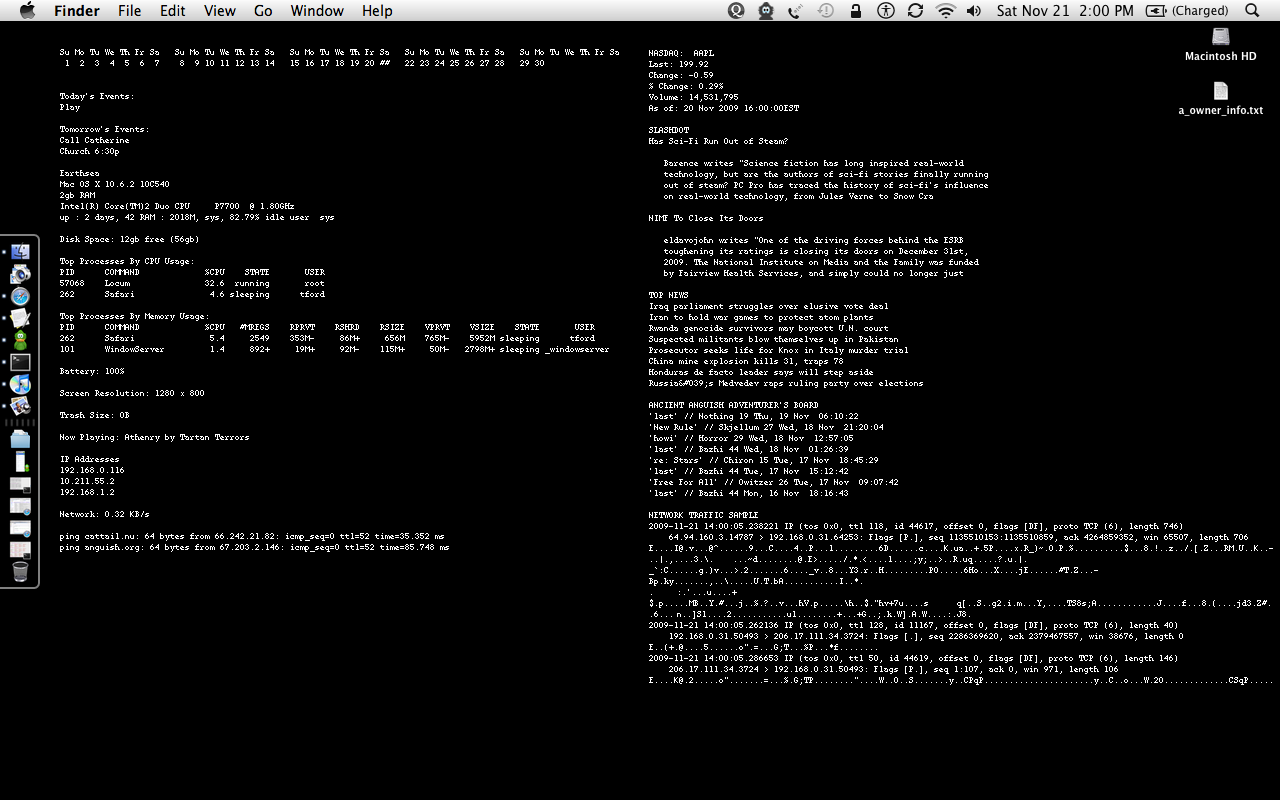GeekTool is an application for Mac OS 10.6+. It lets you display various kinds of information on your desktop via 3 default plug-ins: file plugin to monitor MacOS X activity with. Mega Roundup of GeekTool Scripts on Francesco Mugnai's blog (which contains links to many other sites). In the video, I show one GeekTool entry that displays my external IP address, which can be. Download my GeekTool scripts (version 2.0): 3. Unzip the archive, and move the folder called 'WKGeekToolResources' to /Users/Shared/ (If you can't figure out how to get there, open a Finder window and hold down shift + command + G; then, paste '/Users/Shared/' and click Go) 4. This is the little brother in the Geeklet family, but very powerfull. If you are not happy with the Script Geeklet, Web will unleash your creativity. It works the same way, but instead of just text, you display a full web page, or generate your own HTML code using your own script. GeekTool by Tynsoe.org is licensed under a Creative Commons Attribution-NonCommercial-NoDerivatives 4.0 International License. Jan 04, 2016 Geektool is a program for adding customizable widgets to your Mac's desktop. Geektool runs almost entirely on shell scripts, which update every few seconds to display useful information on the desktop. Customizing Geektool is made easy by packaged scripts called Geeklets, which can be installed quickly and do not require knowledge of shell scripts to use.
| Click here to return to the '10.6: A script to display available Apple software updates' hint |
This would be great if it also checked versions of your installed apps in Applications & ~/Applications for newer versions.
While interesting, that's certainly a complicated process to check for software updates from the command line. Type this in the Terminal to check for updates:
softwareupdate -l
Type this to install the updates (this requires admin rights):
sudo softwareupdate -i -a
Obviously there's other options if you want to gain more control over which updates are installed but that's the basics. You can even run them on a remote machine if you ssh into it first.
http://blog.kaputtendorf.de/2009/02/22/updatecheck/
It works pretty well :)
Thou shalt study thy libraries and strive not to reinvent them without cause, that thy code may be short and readable and thy days pleasant and productive.-- The Ten Commandments for C Programmers. By extension, applies to Unix utilities as well. That said, I didn't know about the command line utility either, and am glad about the comments here often bringing out such solutions.
Is it really a good idea not to run as admin? (OK, bad phrasing--it's never a bad idea. I really mean: is it a bad idea to run as admin?) Running as normal user instead of admin was certainly a good idea on pre-Vista versions of Windows--if you were an admin, you could do anything anywhere and nothing would even try to stop you (or an executable silently running as you).
However, on OS X and newer versions of Windows, you are prompted for your password (or, on Windows, at least just confirmation if you're already an admin) whenever you do anything that requires admin privileges--e.g., modifying anything in the file system besides your profile folder, changing system-wide settings (like power management or the computer's hostname), and the like. You're prompted even if your account currently is an administrator. Even from Terminal (in OS X) you have to sudo for certain commands (and in Windows you'll have to do the equivalent right-click-and-choose 'Run as Administrator,' even if you are one, when you start the command prompt, to give it that extra level of elevation).
I don't really see how it's different, other that running as a non-admin makes you think of the username, as well.

softwareupdate -l from the command line whenever you're curious? Best Geektool Scripts
Concepts
AppleScript has been introduced in GeekTool because some users wanted to extend possibilities in ways that could not be implemented directly into the software.That's why it is a very powerful tool that will let you go far beyond the standard features of GeekTool.
The structure of scriptability in GeekTool is quite simple. The application object is composed of geeklet objects and group objects.
Each geeklet object has a set of properties and attached groups.
Each group can be set visible or not, this has the same effect as enabling or disabling groups in the menu or in system preferences.
Example
An easy way to get a list of geeklet objects is to run this simple script in Script Editor :
This produces an output like this :
As you can see, geeklets are referenced by their ID. This ID is generated when you create the Geeklet from System Preferences, and is unique.
A convenient way to get the ID of a given geeklet is to open GeekTool Preferences, select a geeklet, and double click on the bottom of the inspector palette where the ID is displayed. This will copy the ID in the pasteboard.
You can also get a given geeklet by its name, as long as you did set one in the inspector, like this :
It should return an output similar to this one :
Now you know how to reference Geeklets, let's see what you can do with it.


Manipulating Geeklets
War thunder aimbot hack. This shows how to hide or show individual geeklets :
The only way to get it back is to set the property back to true, or relaunch GeekTool.
This flag will totally ignore groups settings. It will show, or hide a geeklet without checking if the geeklet should be visible or invisible according to currently enabled groups.
From me to you juelz santana zip line. The album was released on August 19, 2003, under,. 'Released: July 20, 2003Professional ratings Review scoresSourceRating(3.2/10)RapReviews(6/10)From Me to U is the debut studio album by American. .
Geektool Scripts 2019

softwareupdate -l from the command line whenever you're curious? Best Geektool Scripts
Concepts
AppleScript has been introduced in GeekTool because some users wanted to extend possibilities in ways that could not be implemented directly into the software.That's why it is a very powerful tool that will let you go far beyond the standard features of GeekTool.
The structure of scriptability in GeekTool is quite simple. The application object is composed of geeklet objects and group objects.
Each geeklet object has a set of properties and attached groups.
Each group can be set visible or not, this has the same effect as enabling or disabling groups in the menu or in system preferences.
Example
An easy way to get a list of geeklet objects is to run this simple script in Script Editor :
This produces an output like this :
As you can see, geeklets are referenced by their ID. This ID is generated when you create the Geeklet from System Preferences, and is unique.
A convenient way to get the ID of a given geeklet is to open GeekTool Preferences, select a geeklet, and double click on the bottom of the inspector palette where the ID is displayed. This will copy the ID in the pasteboard.
You can also get a given geeklet by its name, as long as you did set one in the inspector, like this :
It should return an output similar to this one :
Now you know how to reference Geeklets, let's see what you can do with it.
Manipulating Geeklets
War thunder aimbot hack. This shows how to hide or show individual geeklets :
The only way to get it back is to set the property back to true, or relaunch GeekTool.
This flag will totally ignore groups settings. It will show, or hide a geeklet without checking if the geeklet should be visible or invisible according to currently enabled groups.
From me to you juelz santana zip line. The album was released on August 19, 2003, under,. 'Released: July 20, 2003Professional ratings Review scoresSourceRating(3.2/10)RapReviews(6/10)From Me to U is the debut studio album by American. .
Geektool Scripts 2019
Manipulating groups
Here is how you can show or hide groups.
Refreshing geeklets
Another useful feature is the refresh (or refresh all) command
This will refresh all geeklets eligible to a refresh action (not File, which are continuous)
tell application 'GeekTool Helper' to refresh all
This will refresh a specific geeklet
tell application 'GeekTool Helper' to refresh geeklet id 'CAD821B6-EBC9-42CF-ADDC-AB3A473D1D7B'
Note the short notation used here, without tell / end tell block, this is standard AppleScript shortcut.
A long form would be :
Getting GeekTool dictionary
There is a little trick to get the GeekTool dictionary in Script Editor because the actual scriptable application is hidden into the .prefPane bundle.
- In Script Editor, open the Library from the Window menu (Or Shift-Command-L)
- Go to
/Applicationsdirectory in the Finder - Right click (or control click) on GeekTool, and choose 'Show Package Content'
- Go into
Contents/PlugIns/ - Right click (or control click) on GeekTool.prefPane, and choose 'Show Package Content'
- Go into
Contents/Resources/ - Drag and Drop 'GeekTool Helper' application to the Library window of Script Editor
Geektool Scripts Weather Image
A more complex example
Geektool Scripts
This script displays a dialog where you can select one or multiple geeklet to refresh nowCourtesy of Philippe M.
